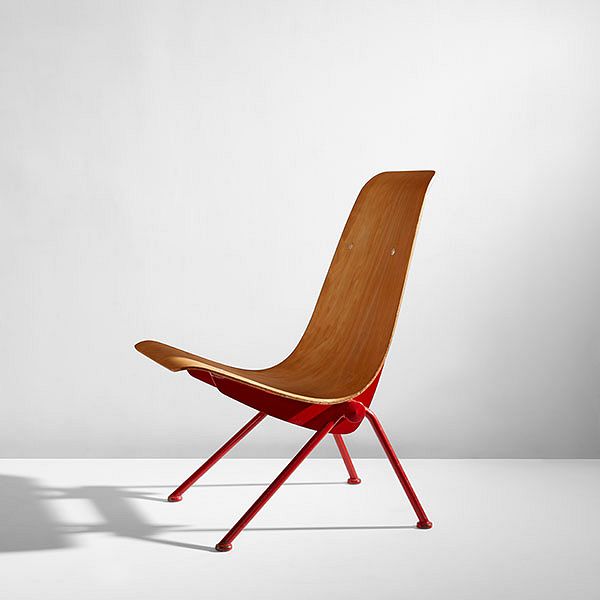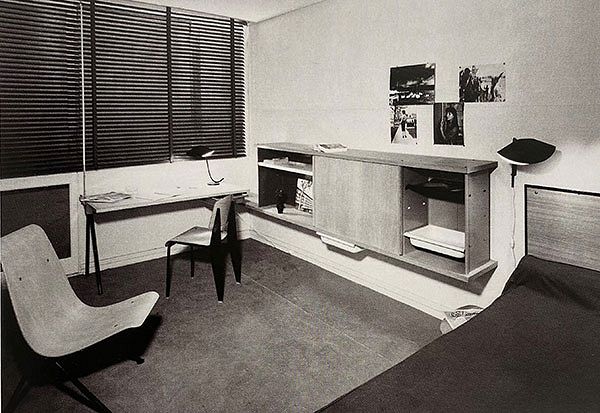Dormitory interior, Cité Universitaire d’Antony.
When one thinks of college dormitory furnishings, French postwar design may not be the first image to come to mind; however, dorm rooms designed by the formidable milieu of Jean Prouvé, Serge Mouille, and Charlotte Perriand were a reality for a few lucky students in France during the 1950s and 1960s. Postwar reconstruction gave way to a boom in production and creativity, with design turning to principles of function, experimentation, and economies of scale. A typical room in the Antony Residence Hall, a students’ housing building in a southwestern suburb of Paris, for example included furnishings by these leading designers. In 1954 the Ministry of Education announced a competition to furnish the residence, selecting the proposals submitted by the Ateliers Prouvé. Collaborating with Perriand and Mouille to maximize space and comfort in each room, Prouvé furnished the interiors with his now classic Antony and Semi-metal chairs, as well as Mouille’s Antony table and wall lamps. The result is an urbane living space, conducive to both study and leisure.

Jean Prouvé, Set of four Semi-metal"chairs, model no. 305, designed 1950, produced 1950-1969. Design New York.
The genesis for Prouvé’s Semi-metal chairs began in 1934; due to wartime metal shortages, however, production quantities were limited relative to the amount Prouvé sought to make. The rear legs of the model are made from sturdy sheet metal to carry the weight of the chair and sitter, allowing for the more delicate tubular front legs. The model’s popularity burgeoned when the component materials became more widely available again in the 1950s – Prouvé even furnished his own home in Nancy with the chairs, placing them around his dining room table. The deceptively simple design and scalable form shows an emphasis on economy and function while still embracing formal interest and the social consciousness of postwar design merging with mass production. Widely considered an important contribution to 20th century design, the model is in the permanent collections of the Museum of Modern Art, New York, and the Centre Pompidou, Paris.

Jean Prouvé, Antony chair, model no. 356, circa 1954. Design New York.
The Antony chair is one of Jean Prouvé’s most celebrated and enduring designs. Prouvé devised the model in 1954 for a dormitory hall at the Cité Universitaire d’Antony, winning the design competition put forth by the institution and Ministry of Education. With its elastic use of plywood – which in the present piece arcs slightly to form the curved silhouette of the chair’s seat – along with its sheet metal skeleton and tubular metal legs, the chair demonstrates Prouvé’s brilliant material use. Prouvé considered the dimensions of the dormitory and how students used the space and furniture in their daily habits and social engagements; originally called the "seagull" due to its shape, students often individualized the chair with cushions.
The lightweight and visually pleasing form was ideal for versatile use in waiting rooms, home spaces, and offices, leading to the chair becoming embraced beyond the university dormitory and its common appellation as the “Light easy” chair. Many institutions hold an Antony chair in their permanent collections, including the Museum of Modern Art, New York and The Metropolitan Museum of Art, New York.

Serge Mouille, Pair of Antony desk lamps, circa 1955. Design New York.
Attempting to modernize French lighting design in the early 1950s, Serge Mouille designed an entire range of lights that utilized the same materials, colors, and forms from model to model. The endeavor standardized Mouille’s production and created a hallmark aesthetic typified by black painted metal forms that balanced organic and dramatic elements. As Mouille described it: “I always need to include an accident in a direction in order to break a line and give it an aggressive quality.” The present model, while more streamlined than many of his lamps, still showcases this distinction in the way the hooded shade seems to drift away from the steel disc base.
Mouille designed the present Antony lamp model for the student bedrooms at the Cité Universitaire d’Antony, which placed 296 orders for this lamp in 1955. The final products were delivered in two installments over the following year – of which sixty examples are believed to exist from the period. Mouille produced two iterations of the model: in the first, the neck met the shade in a ball-and-socket brass joint. In the second – as seen in the present example – the longer painted steel tube bends at the top, creating a right angle at the joint for greater flexibility of movement. The model is one of five desk lamp forms for which he is remembered and reflects Mouille’s ingenuity in modernizing French lighting design.
Recommended Reading
